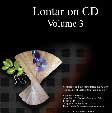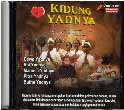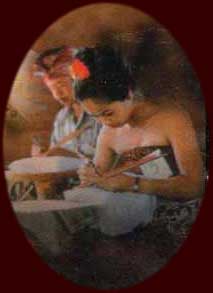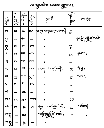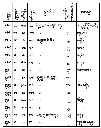Contemporary Use of The Balinese Script
By Ida Bagus Adi Sudewa
v 0.1 - March 3rd, 2003
|
|
The Balinese language ("Basa Bali") is the native language of nearly
3 million people in Bali and the western part of the neighboring island
Lombok. Because Bali is one province of Indonesia, the people of Bali
use the Indonesian language as the official language in schools, government
offices, and other formal institutions. For the native Balinese, the
Balinese language is still popular to use in daily life. The language
is commonly written in two different scripts: the Balinese script and
the Latin script.
This article discusses the history of the Balinese script and the modern
use of the script at the present time.
|
|
|
|
The Balinese script is without doubt derived from Pallava script from
India. The shape of the script shows similarities with southern Indian
scripts like Tamil. The concept of syllable also found in other South/Southeast
Asian scripts, such as Devanagari, Tamil, Thai, Lao, and Khmer scripts.
The Balinese script closest sibling is the Javanese script, which have
rectangular form of font shape compared to round shape of Balinese script.
The lontar writing tradition started around the tenth
century AD, during the reign of Sri Gunapriya-Dharmapatni and Dharma
Udaya Warmadewa. This tradition may actually have started in the eighth
century, under the guidance of a priest named Rsi Markandeya. The evidence
for this is based on the discovery of ‘Bhuwana Tattwa Maha Rsi
Markandeya’, which described the presence of Priest Markandeya
in the obtaining of new farming land in Taro Village, Tegallalang. According
to that lontar, Priest Markandeya went to Mount Agung to build a simple
stone shrimp with ‘pedagingan’ (magical equipment) of Panca
Datu (5 metals: silver, copper, gold, iron and berumbun or a mixture
of those 5 different colors)
|
|
|
|
The following literatures are traditionally written using the Balinese
script. I have limited knowledge about whether the script is used for
writing modern story/ articles, but I am sure they exist. [Someone please
help here]
|
|
Babad
(History)
|
|
Tutur (Advice)
|
|
Usadha
(Medical Prescription)
|
|
Kidung
(Chorus)
Kidung is the ritual chorus sung simultaneously
by dozen singers. The most well known kidung is Kidung
Wargasari, describing the descendant of God and deities cheered
by various offering of Gamelan music, songs, dance, foods, and
other arts to receive their blessings.
Kidung Malat is also popular with the love adventure
of prince Panji and princess Rangkesari.
|
|
Kakawin
(Verses)
The performance of kakawin is a ritualistic oral
reading for a religious celebration, similar to that of the ancient
Greek Rhapsodies. Reciting story from the epic of Ramayana,.Mahabharata,
and other stories one rhapsodist reads the poem in a highly strict
musical rules and another alternately translates it into a high
dignified Balinese language. In contemporary Bali, numerous temple
festivals and other religious celebrations feature kakawin recital
on a special site with amplifier.
|
|
Gaguritan (Dramatic Recitation)
Gaguritan is the traditional narrative
rhyme written in Balinese language rather than Kawi language.
The vocal types that compose a play of a Gaguritan is known
as Pupuh.
|
|
|
|
There are still about two dozen names of
pupuh in Bali which dominate the performance of Balinese
opera, the Arja sung dance drama. Among the most popular
gaguritan includes: Jayaprana, Senepati Salya, Sampik Engtay
(based on a Chinese story), Tamtam, Cangak, and Basur.
|
|
|
Sekar
Rare (Children's Story Telling)
Sekar Rare is the Balinese lullaby, sung frequently
by a (grand) mother to her (grand) baby, or by and among the playing
children. There are a countless number of these types, with varying
content from the clear narrative meaning to the tricky unsolved
puns.
|
These all are the source of various genres of the-
Balinese tragedy, comedy, & tragicomedy.
|
|
|
Since its beginning, the Balinese script has been written in various media:
| 1 |
|
Stone carving / inscription (a.k.a.
Prasasti).
This was the most popular media of the past. It is also
the source of information that can be preserved through
centuries. It is still used up until the present days, e.g.
in temples to mark the temple establishment day and for
other historical event.
|
|
|
|
Carving
on Granite
Marble
|
|
|
Click thumb-nail
to zoom
|
|
|
| 2 |
|
Lontar
palm leaves.
This was the most popular media for writing stories, since
nobody can carve stones to write thousands of lines. It
was made from palm leaves -‘rontal’ in Balinese.
|
|
|
|
A page
of lontar. One lontar book may contains
10 - 200 pages like this.
|
|
|
Click thumb-nail
to zoom
|
|
|
List
of lontar title kept in Gedong Kirtya Museum - Singaraja.
Lontars are often considered sacred, and not every person
can study its contents. Kids and young people are usually
not permitted to read lontar. There is even a special holy
day that people bless lontar collection that they have.
|
|
| 3 |
|
Paper.
Once the Balinese people know about papers and learn about
publishing, the contents of lontar were start moving into
more practical media, paper. Almost every Balinese family
read religious texts from books instead of lontar. Lontar
remains sacred, while the contents are no longer sacred
and can be read by anyone from books.
|
 |
 |
|
Kakawin book
|
Inside page
|
|
|
Click thumb-nail
to zoom
|
|
|
Here are the list of publishers currently
active in publishing books in Balinese script
- P.T. Upada Sastra
- <help to fill this>
|
|
| 4 |
|
Digital Media.
Efforts had been made to preserve the lontar manuscript
using the computer. Many lontars were converted into digital
image. Various Compact Disc have been circulated in the
community, and some are downloadable from the Internet,
allowing people to access it from all over the world..
|
|
|
|
|
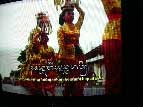 |
|
CD-Books
|
Karaoke VCD
|
CDs / VCDs
|
TV Broadcast
|
|
|
Click thumb-nail
to zoom
|
|
|
In addition of lontar image capturing, a computerized
TrueType font for Windows of Balinese script is also available. It was
developed by a Balinese I Made Suatjana
and is freely downloadable from http://www.babadbali.com/aksarabali/balisimbar.htm.
This font is widely used for many published books.
|
|
|
|
Most of the streets in Denpasar (the capital city of Bali) now
have street names written in both Latin and Balinese. And so do
the villages’ border sign (“Welcome to the ... Village”).
|
|
|
|
|
|
Jalan Puputan
|
Banjar Tampak
Gangsul
|
Lapangan Puputan
Margarana
|
|
|
Click thumb-nail to
zoom
|
|
|
Traditionally, temple announcements are in Balinese
script, often without any Latin scripts at all. Building names
inside the temples are in Balinese script only.
|
|
|
|
|
|
Temple
Announcement
|
Gedong Ratu
Pemayun
|
'Rajah' at
Pura Desa Sanur
|
|
|
Click thumb-nail to
zoom
|
|
|
Government offices’ building names are always
in Balinese. But it doesn’t apply to any letterheads or documents.
|
|
|
|
|
|
Bali Governor's
Office
|
Local Parliament
Building
|
Bali Development
Bank
|
|
|
Click thumb-nail to
zoom
|
|
|
Even private houses and greetings.
|
|
|
|
|
|
'Ngranjing' means
Please Come In
|
Om Swastyastu
May God Bless You
|
Wrongly spelled
'Medal' or Exit
|
|
|
Click thumb-nail to
zoom
|
|
|
|
|
|
Perhaps the most frequent use of Balinese scripts
are in ‘Sekaha Pesantian’ (Kakawin Reading Group) in
banjar. A little explanation about Balinese community should help
here. The smallest organization of a neighborhood is called banjar.
The size of one banjar varies from ten to hundreds of families.
A complete banjar has its own kindergarten, youth group, women
group, gamelan musical group, kakawin reading group, and now even
a internal security group (pacalang). There are around 1300 banjars
exist in the island (with 3 million people). Banjars in nearby
location formed desa pakraman (village). Unfortunately, the sekaha
pesantian organizations are loose and no sekaha pesantian exists
at the village level.
My father is a member of sekaha pesantian in
our banjar. As a kid, I followed him went to the sekaha reading
sessions. The situation was similar to the one in a karaoke room,
everyone is eager to take turn reading. In one turn, there were
three people participating; one reading (sounds more like singing)
the Kawi text, one translating to Balinese, and the last one telling
the description about the meaning or the moral story of the verse.
Of course the singing part is the most exciting one that also
requires the higher skills. Those sessions can take hours, even
from dusk until dawn.
The percentage of women in the sekaha is generally
low. It is perhaps related to the traditional view of women in
domestic matters and lack of interest among the women themselves.
But there are no rules whatsoever about women membership, anyone
can join the group. Sadly, for most of the Balinese, there are
no habits of writing new literatures. Old literatures
are reproduced and recited over and over for years. Maybe writing
is a strange activity for the Balinese, because of its individualistic
nature compared to social gathering of sekaha sessions.
|
|
|
|
Less frequently, sekaha pasantian also formed in office or schools,
which together with banjars’ sekeha continue to preserve
the tradition of pasantian.
|
|
|
|
|
The Indonesian proclamation of Independence on August 17 th 1945
brought the Indonesian archipelago together in one state. The
founding fathers of Indonesia decided on Bahasa Indonesia as the
national and official language. Bahasa Indonesia originally was
a dialect of Malay spoken by people of Riau in Sumatra Island.
This dialect is commonly written in Latin script, and less frequently
using a kind of Arabic script called Jawi. Since the introduction
of Bahasa Indonesia to the Balinese people, it becomes the official
language in Bali also, used commonly in schools and offices, although
people still are using the native Balinese language in daily life.
Although math and sciences are taught using Bahasa
Indonesia, the Balinese language and alphabets is a compulsory
subject for primary and secondary school students in Bali. Since
the 3rd grade in school, students spend two hours weekly to study
the language and the alphabet, the same hours they also spend
for learning English. For most students, learning Balinese language
is fun, because most of them already use it at home and in other
traditional community group. But learning the scripts is not as
easy. How can a student master an alphabet if they only use it
for two hours a week? There’s a popular saying among students
“malajah basa bali, macane takutin” which has double
meaning, “learning Balinese language, we are afraid of the
reading part” or “learning Balinese language, we are
afraid of tiger”. That’s why, after I graduated from
high school, only one person in my class could read the Balinese
script with a decent speed. And that’s after ten years of
learning!
The most popular book for students learning the
Balinese script is “Purwa Aksara”, by author I Wayan
Simpen, A.B. This man of letters actually had written all the
Purwa Aksara editions ranging from 3 rd grade until 12 th grade.
They are reprinted over and over again without major modifications
from <19xx> until the present date. In one text, we still
can read that the price for one plate of rice is Rp 25, which
is nonsense for year 2003 (at least Rp 2000 now for decent meal).
There are rarely any grammar lessons inside Purwa
Aksara and the contents are mostly texts. The teachers are expected
to teach the letters, grammar, and rules then use Purwa Aksara
for students to practice reading. The emphasis of the course is
mostly on reading, not writing. It is one reason the lack of students’
capability of reading. I personally feel that writing is essential
for learning an alphabet. One can read a text fluently with continuous
reading practice, then will forget it within a week. Writing (not
only copying), in the other hand, would make the brain memorize
the letters more permanent than only reading.
In Purwa Aksara for elementary school, a lot
of the contents are nouns and their picture. For more advanced
students in high school, the book contains mostly short stories.
I remembered in my high school times, each student had to read
one or two paragraph of text loudly in front of the class. Because
of the inability of most of the students to read the whole story,
we took the short cut. The first student in the teacher’s
list is always read the first paragraph. He is a lucky guy (His
name starts with ‘A’, that’s why he was always
first). The remaining of the class guessed his/her part, and learnt
only those paragraphs. If he/she wrongly guessed, he/ she was
in trouble, and might stand in front of the class until the bell
rang.
The English courses, which took the same two
hours a week enjoyed more attention both from the teachers or
the students. While teaching Balinese is a part time job (Balinese
language teachers are actually teach other subjects, usually also
teach Hindu Religion subject), English teachers are really English
teachers. They are educated as English teacher. They can have
part time job as tour guides, or giving private English courses
after school times. For the students, learning English is essential
for their future, as well as can improve their GPA. Balinese language
subject is not part of the GPA, and they simply put no extra effort
of learning it..
|
|
|
|
Will the Balinese script reading skills be lost
over generations? I don’t think so. Some of the students
will be interested in the script at their middle ages, like what
their parents did. Personally I am not afraid that the skills
will vanish. But I suggest improvements of the teaching method
of Balinese script (and also language) in school. Two hours a
week for ten years should produce output with better quality than
what are produced now. Reading religious texts are not only for
the old people, but it’s for everybody.
|
|
|
|
- The University of Udayana in Denpasar has a dedicated Department
of Balinese Letters
- The Indonesia Hindu University in Denpasar
- IKIP ??
|
|
|
|
As long as the Balinese still maintain their tradition, the Balinese
script will still be in use. However, I suggest that improvements should
be made into the teaching and research of Balinese language and script.
- There should be more books produced for children to learn about
Balinese script. I think an illustrated and colorful dictionary is
a perfect tool to learn.
- Purwa Aksara should be updated. I remember the story in Purwa Aksara
about a boy named Molog that have his pigs stolen from its fence.
Well, most of the boys in the urban Bali area have their nice Sanskrit
names now (it’s a trend now to give sanskrit names for newborn
babies), while “Molog” is traditional name that are not
popular anymore. Examples of fruit names are also refer to the traditional
fruit of Bali while now Balinese kids are more familiar with Sunkist
or New Zealand apples. As I mentioned before, the price of one plate
of rice is no longer Rp 25, it shows how old this book really is.
- I don’t know the research done in Udayana University [please
update me]. The only complete literature I know about Balinese grammar
(‘Pasang Aksara’) is a very old book by the author of Purwa
Aksara. There are now character encoding scheme for Balinese script.
There is only one computerized font that is just a collection of glyphs
that doesn’t follow any encoding.
|
|
|
|
I borrow the whole description of kakawin, kidung, gaguritan, and sekar
rare from University of Georgia web site (http://www.drama.uga.edu/pages/ofspecin/indiapgs/Balisite/pages/Proto-Theatrical%20Practice.html)
|
|
|
|
|




